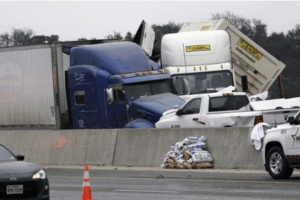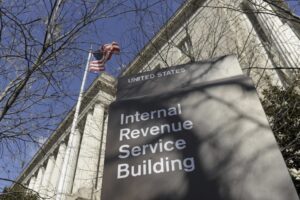WASHINGTON — President Joe Biden announced on Thursday, June 24, that “we have a deal,” signaling a bipartisan agreement on a $953 billion infrastructure plan that would achieve his top legislative priority and validate his efforts to reach across the political aisle.
Biden made a surprise appearance in front of the cameras with members of the group of senators, Republicans and Democrats, after an agreement was reached Thursday. Details of the deal were scarce to start, but the pared-down plan, with $559 billion in new spending, has rare bipartisan backing and could open the door to the president’s more sweeping $4 trillion proposals later on.
The president said not everyone got what they wanted and that other White House priorities would be done separately in a congressional budget process known as reconciliation
“We’ve struck a deal,” Biden then tweeted. “A group of senators — five Democrats and five Republicans — has come together and forged an infrastructure agreement that will create millions of American jobs.”
We’ve struck a deal. A group of senators – five Democrats and five Republicans – has come together and forged an infrastructure agreement that will create millions of American jobs.
— President Biden (@POTUS) June 24, 2021
The senators have struggled over how to pay for the new spending but left for the White House with a sense of confidence that funding issues had been addressed.
Biden’s top aides had met with senators for back-to-back meetings on Capitol Hill and later huddled with House Speaker Nancy Pelosi and Senate Majority Leader Chuck Schumer.
The agreement comes with a complex legislative push. Pelosi on Thursday welcomed the bipartisan package, but she warned that it must be paired with the president’s bigger goals now being prepared by Congress under a separate so-called the budget reconciliation process.
“This is important,” Pelosi said. “There ain’t going to be a bipartisan bill without a reconciliation bill.”
The Democratic leader vowed the House would not vote on it until the Senate had dealt with both packages.
The major hurdle for a bipartisan agreement has been financing. Biden demanded no new taxes on anyone making less than $400,000, while Republican lawmakers were unwilling to raise taxes beyond such steps as indexing the gasoline tax to inflation. But senators departed for the White House Thursday with a sense of confidence that funding issues had been addressed.
“We’re still refining the details, but from my perspective, it is paid for,” said Maine Sen. Susan Collins, a Republican and one of 10 lawmakers who met with Biden for roughly 30 minutes.
Republican Bill Cassidy of Louisiana said he was confident the agreement had Biden’s backing.
“We wouldn’t be going there if he wasn’t supportive of the deal,” said Cassidy, adding that the president “wants to make it flourish.
One member of the bipartisan group, Republican Rob Portman of Ohio, met privately ahead of the White House meeting with Senate Republican leader Mitch McConnell at the Capitol and said afterward that the Kentucky senator “remains open-minded and he’s listening still.”
Biden has sought $1.7 trillion in his American Jobs Plan, part of nearly $4 trillion in broad infrastructure spending on roads, bridges and broadband internet but also including the so-called care economy of child care centers, hospitals and elder care.
With Republicans opposed to Biden’s proposed corporate tax rate increase, from 21% to 28%, the group has looked at other ways to raise revenue. Biden rejected their idea to allow gas taxes paid at the pump to rise with inflation, viewing it as a financial burden on American drivers.
The broad reconciliation bill would likely include tax increases on the wealthy and corporations, so a tension still exists over funding for some Republicans and business groups. The U.S. Chamber of Commerce came out Thursday applauding the bipartisan infrastructure agreement, but Neil Bradley, its executive vice president, warned that “some in Congress are trying to torpedo the deal” unless they get trillions in additional spending.
“These are the kind of tactics that have created the mess we are in today, and they must be rejected,” Bradley said.
According to a White House readout of the Wednesday, June 23, meeting with Schumer and Pelosi, the leaders talked with acting Budget Director Shalanda Young, National Economic Council Director Brian Deese and Domestic Policy Council Director Susan Rice, and they discussed the two-track approach — the smaller bipartisan deal now emerging and the more sweeping plan of Democratic priorities.
Schumer said the leaders “support the concepts” they have heard from the bipartisan negotiations.
The Democratic leaders also insisted on the two-part process ahead, starting with initial votes in July to consider the bipartisan deal and to launch the lengthy procedure for the Democrats’ proposal, now drafted at nearly $6 trillion.
The Democrats’ bigger proposal would run through the budget reconciliation process, which would allow passage of Biden’s priorities by majority vote, without the need for support from Republicans to overcome the Senate’s 60-vote threshold. It would require multiple rounds of voting that are likely to extend into fall.
Like Pelosi, Schumer said, “One can’t be done without the other.”
That’s a signal to both parties of the road ahead. Liberal Democrats have been wary of the bipartisan effort because they see it as insufficient and worry it will take the place of Biden’s bigger plan. Republicans are also skeptical of passing a bipartisan bill only to be faced with an even bigger Democratic plan.
By Lisa Mascaro, Josh Boak and Jonathan Lemire, The Associated Press. Associated Press writer Kevin Freking contributed reporting.
The Associated Press is an independent global news organization dedicated to factual reporting. Founded in 1846, AP today remains the most trusted source of fast, accurate, unbiased news in all formats and the essential provider of the technology and services vital to the news business. The Trucker Media Group is subscriber of The Associated Press has been granted the license to use this content on TheTrucker.com and The Trucker newspaper in accordance with its Content License Agreement with The Associated Press.








